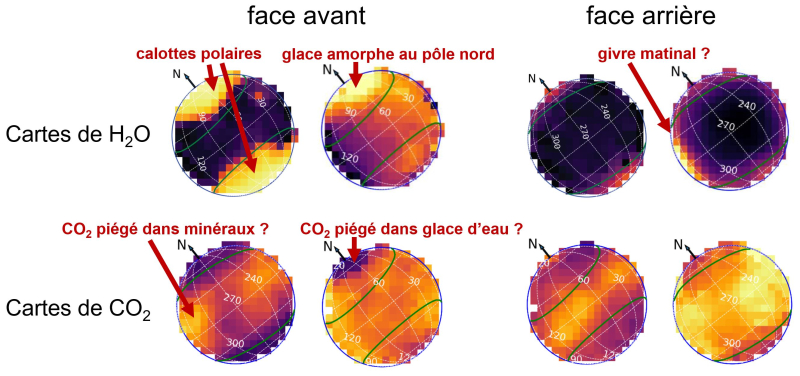Under its icy crust, Ganymede is home to the largest ocean of liquid water in the Solar System. To understand its formation and internal composition, we need to decipher the clues present on its surface.
The James Webb Space Telescope has revealed new details about the texture and nature of Ganymede’s surface constituents.
Spectra obtained at infrared wavelengths by the NIRSpec instruments [1] and MIRI [2] Observations of Ganymede were carried out using the MRS (medium resolution spectroscopy) component.]] confirm that the surface is fairly rough and that its first few micrometers of thickness are generally porous and mainly made up of crystalline water ice.
At the poles
The polar regions are covered with more water ice, especially in amorphous form, a phase in which H2O molecules are disordered.
These particular properties of polar ice could be explained by the bombardment of particles from the magnetosphere of Jupiter, more intense at the poles than at the equator because of the magnetic field of Ganymede.
This bombardment also causes the decomposition of H2O and the formation of new molecules, such as hydrogen peroxide (H2O2), detected for the first time in the polar regions.
On the backside of Ganymede
The terrain at the edge of the east seems to be covered with morning frost, sublimating during the day. Finally, carbon dioxide (CO2) appears to be trapped on the surface in minerals or salts at low latitudes, and in water ice at high latitudes. It could be produced by the decomposition of organic molecules.
Thus, despite the low temperatures that prevail, between -180 and -110°C, and the absence of a thick atmosphere, the surface of Ganymede experiences chemical transformations and perhaps diurnal variations.
This information will help optimize the operations of the European Space Agency (ESA) space probe JUICE which will orbit Ganymede in 2034. [3]
Laboratories involved :
|
Scientific references
- "Composition and thermal properties of Ganymede’s surface from JWST/NIRSpec and MIRI observations", by D. Bockelée-Morvan et al., A&A, 2023.
The paper was accepted on October 20, 2023 for publication in Astronomy & Astrophysics.
OID 10.1051/0004-6361/202347326 - "Hydrogen peroxide at the poles of Ganymede", by Samantha K. Trumbo et al., Sci. Adv.9, eadg3724 (2023).
[1] NIRSpec (Near Infrared spectrograph) was built for the European Space Agency (ESA) by the Astrium consortium. Observations of Ganymede were made using the ’integral field unit’ (IFU) mode,
[2] MIRI (Mid-Infrared Instrument) was proposed, designed and built by a European consortium, under the aegis of ESA, in collaboration with JPL. France participated in the instrument’s construction through the Centre national d’études spatiales (CNES).
[3] These observations were acquired as part of the Early Science Release program ERS 1373 “ERS observations of the Jovian System as a demonstration of JWST’s capabilities for Solar System Science”.
Their analysis is funded by the National Research Agency (programme PRESSE, ANR-21-CE49-0020-01).

